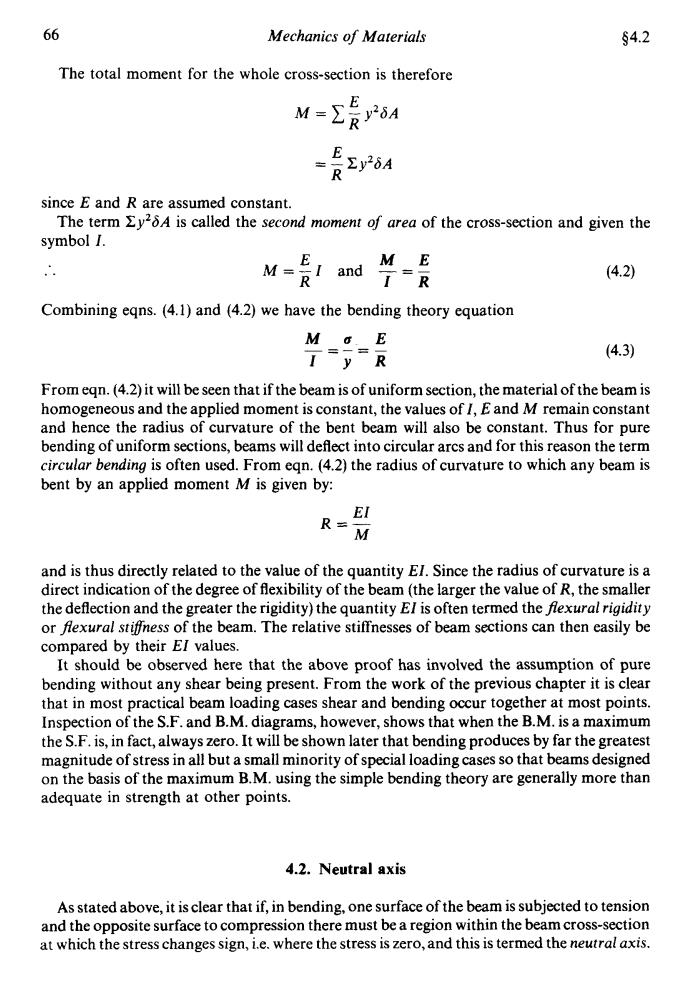正在加载图片...

66 Mechanics of Materials §4.2 The total moment for the whole cross-section is therefore M=发A E EEyOA since E and R are assumed constant. The term Ey26A is called the second moment of area of the cross-section and given the symbol I. E ME -RI and T-R M= (4.2) Combining eqns.(4.1)and(4.2)we have the bending theory equation M G E T-)-R (4.3) From eqn.(4.2)it will be seen that if the beam is of uniform section,the material of the beam is homogeneous and the applied moment is constant,the values of I,E and M remain constant and hence the radius of curvature of the bent beam will also be constant.Thus for pure bending of uniform sections,beams will deflect into circular arcs and for this reason the term circular bending is often used.From eqn.(4.2)the radius of curvature to which any beam is bent by an applied moment M is given by: EI R= M and is thus directly related to the value of the quantity EI.Since the radius of curvature is a direct indication of the degree of flexibility of the beam(the larger the value of R,the smaller the deflection and the greater the rigidity)the quantity El is often termed the flexural rigidity or flexural stiffness of the beam.The relative stiffnesses of beam sections can then easily be compared by their EI values. It should be observed here that the above proof has involved the assumption of pure bending without any shear being present.From the work of the previous chapter it is clear that in most practical beam loading cases shear and bending occur together at most points. Inspection of the S.F.and B.M.diagrams,however,shows that when the B.M.is a maximum the S.F.is,in fact,always zero.It will be shown later that bending produces by far the greatest magnitude of stress in all but a small minority of special loading cases so that beams designed on the basis of the maximum B.M.using the simple bending theory are generally more than adequate in strength at other points. 4.2.Neutral axis As stated above,it is clear that if,in bending,one surface of the beam is subjected to tension and the opposite surface to compression there must be a region within the beam cross-section at which the stress changes sign,i.e.where the stress is zero,and this is termed the neutral axis.66 Mechanics of Materials $4.2 The total moment for the whole cross-section is therefore E R = - Z y26A since E and R are assumed constant. symbol I. The term Cy26A is called the second moment of area of the cross-section and given the (4.2) Combining eqns. (4.1) and (4.2) we have the bending theory equation MaE IYR ---=- - (4.3) From eqn. (4.2) it will be seen that if the beam is of uniform section, the material of the beam is homogeneous and the applied moment is constant, the values of I, E and M remain constant and hence the radius of curvature of the bent beam will also be constant. Thus for pure bending of uniform sections, beams will deflect into circular arcs and for this reason the term circular bending is often used. From eqn. (4.2) the radius of curvature to which any beam is bent by an applied moment M is given by: and is thus directly related to the value of the quantity El. Since the radius of curvature is a direct indication of the degree of flexibility of the beam (the larger the value of R, the smaller the deflection and the greater the rigidity) the quantity El is often termed the jexural rigidity or flexural stiflness of the beam. The relative stiffnesses of beam sections can then easily be compared by their El values. It should be observed here that the above proof has involved the assumption of pure bending without any shear being present. From the work of the previous chapter it is clear that in most practical beam loading cases shear and bending occur together at most points. Inspection of the S.F. and B.M. diagrams, however, shows that when the B.M. is a maximum the S.F. is, in fact, always zero. It will be shown later that bending produces by far the greatest magnitude of stress in all but a small minority of special loading cases so that beams designed on the basis of the maximum B.M. using the simple bending theory are generally more than adequate in strength at other points. 4.2. Neutral axis As stated above, it is clear that if, in bending, one surface of the beam is subjected to tension and the opposite surface to compression there must be a region within the beamcross-section at which the stress changes sign, i.e. where the stress is zero, and this is termed the neutral axis